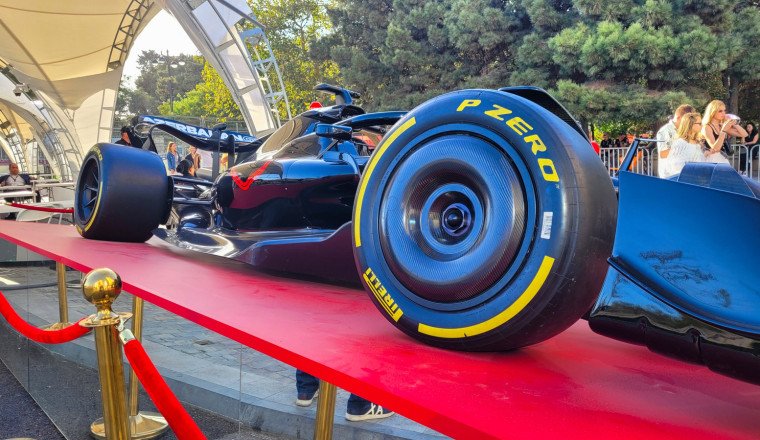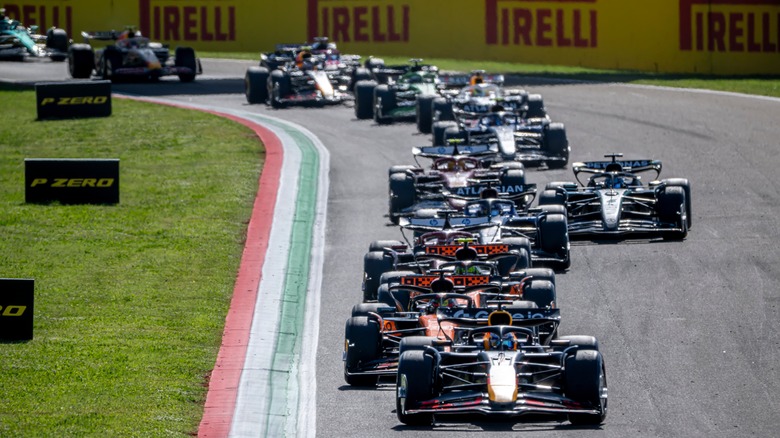
The cinematic spectacle that is "F1: The Movie" is likely to boost the sport's popularity to new heights, but it didn't really need much help. According to Nielsen Sports (via Forbes), Formula 1's global fanbase grew by more than 10% in 2024 compared to 2023. It's the second straight year of double-digit growth, with some 826.5 million people now considered F1 fans — and that includes way more women than ever.
Part of that, no doubt, is the lingering effect of the Netflix show "Formula 1: Drive to Survive," developed with the backing of the sport's governing body, the FIA (Fédération Internationale de l'Automobile). Yet that's just one of the many ways Formula 1 proactively works for fan engagement, and putting different colored stripes on the cars' tires is actually another. The colors designate the separate rubber compounds used for each tire, as we'll explain in a minute, and that makes it easier for fans, as well as broadcasters, to follow teams' tire moves. For instance, you can easily tell when a driver changes tactics, switching tire compounds, by noticing the changes in stripe color.
Formula 1 tires are made from a variety of materials, starting with a mix of natural and synthetic rubbers. By adjusting that mixture, along with the ratios of other materials used, you can fine-tune the way the resulting compounds perform on the track.
For the 2025 F1 season, Pirelli, the official tire supplier to the series, has developed seven compounds, with six now in play. The year began with compounds going from C0 to C5, with the lower number being the harder tire. A new soft compound, C6, will be introduced for the Italian Grand Prix in September. The company provides tires using three of those compounds for each race weekend, and the teams can use them as they see fit — although they have to use at least two of the three compounds at some point during the event, and using wacky water tricks in the tires is definitely not allowed.
The hardest of the three tire compounds on a given weekend get white stripes, the medium tires wear yellow stripes, and the softest tires show off red stripes. Those are considered suitable for dry tracks, and Pirelli also provides tires for wet conditions (with blue stripes) and intermediate weather conditions (with green stripes).
Each team only has a limited number of tires to use during the weekend, and every lap presents almost endless possibilities for gaining an advantage by choosing the right ones. Softer-compound tires may grip the track better for enhanced performance, but they won't hold up as long to the ongoing punishment of racing. Drivers can get more miles out of the harder, more durable tires, but they'll have to sacrifice some speed and handling.
It can be a similar type of story with deciding whether or when to use dry tires versus intermediate or wet ones. When long-time racer Nico Hülkenberg recently proved F1 fairytales still happen, earning his first podium finish in 239 starts, his team's tire strategy made a major difference: The Hulk went to intermediate tires during part of the British Grand Prix while many rivals stayed with dry-weather rubber, allowing him to make a serious move in the standings under rainy skies.
Here, the difference in tires was mostly design, as dry-weather tires, regardless of compound, are slicks; they have no treads or other features to channel water out of the way. This allows for more rubber to meet the road, but it makes them prone to dangerous hydroplaning when water's on the track. The trade-offs go the other way with intermediate and full wet tires. That helped things go Nico's way at Silverstone.

















Facebook Conversations